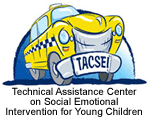

Implementing Effective Practices to Support Young Children’s Social Emotional, Language, and Early Literacy Development
A Collaboration between TACSEI and CELL
Promoting Social Emotional Development |
SHARED PRACTICE |
Promoting Language and Literacy |
| Level 3 - PROVIDING TARGETED INTERVENTIONS FOR CHILDREN WITH SUPPORT NEEDS | ||
| Encouraging children who are working together, supporting their peers, and interacting appropriately promotes social development. |
3.1 Make positive and specific comments about children who are working together, helping each other. |
Lots of specific comments and encouraging verbal interactions with peers builds vocabulary and language skills. |
| Teaching and discussing friendship skills with children encourages prosocial development and creates a climate of caring. |
3.2 Use a variety of strategies to specifically teach new skills. |
Instructional adaptations can help children learn new skills and behaviors. |
| The promotion of friendship skills is enhanced when teachers provide multiple opportunities for children to initiate and practice friendship skills. | 3.3 Provide intentional learning opportunities that promote the development of all children. |
Identify and provide learning opportunities involving you or the child’s peers that encourage the use of language and print skills. |
| Teacher’s note and model friendship skills as they interact with children and other adults in the classroom. | 3.4 Model skills and behaviors with children and other adults. |
To highlight the functional purpose of literacy for children, be sure to model and talk about literacy activities you use every day in the classroom (e.g., I’m writing my to-do list). |
| By teachers labeling their own emotions, children learn the language of emotion expression and how to appropriately express emotions. | 3.5 Model and label my own emotions and appropriate ways to express emotions. |
To support children’s development of receptive and expressive emotional language. |
| Teachers might use books, songs, games, puppets, role plays, art, and embedded learning opportunities to provide children with multiple opportunities to identify and express emotions. | 3.6 Use a variety of strategies to teach children about emotion words and how to recognize emotions in themselves and others. |
To encourage expressive and receptive language regarding emotions through literacy activities, such as books, songs, role play, etc. |
| By validating children’s emotions, children learn that they can express their emotions in appropriate ways. | 3.7 Validate children’s emotions by labeling them and allowing them to talk about how they feel. |
To support children’s exploration of their emotions and enhance receptive and expressive language. |
| Support children in developing strategies for coping with and regulating their strong emotions such as anger and frustration. | 3.8 Promote the development of self-regulation including teaching strategies that children can use to cope with their strong emotions. |
Use language strategies to help children cope with their strong emotions and learn important vocabulary. |
| Support children in their development of social problem solving by specifically teaching the steps to generate and evaluate problem solutions. Offer materials (e.g., visuals of problem solving steps or solutions) and increased opportunities for children to practice problem solving skills. | 3.9 Specifically teach the steps to solving problems in a variety of ways including engaging children to generate solutions to common classroom challenges. |
When developing activities around problem solving, provide materials (e.g., visuals of problem solving steps or solutions) and increased opportunities for children to practice problem solving skills. |
| Intentional learning opportunities and supports should be provided to promote the social emotional development of children who might have skill delays in understanding and expressing emotions, problem solving, and friendship skills. | 3.10 Provide support to individual children who might need additional learning opportunities, adapted materials, or supports (e.g. peer support). |
To encourage active participation in language and literacy activities provide appropriate adaptations to support an individual child such as adapting the environment to ensure that the child has access to literacy materials, adapting the material within the literacy activity, adapting instruction given to the child, adapting the activity, or providing physical assistance. |